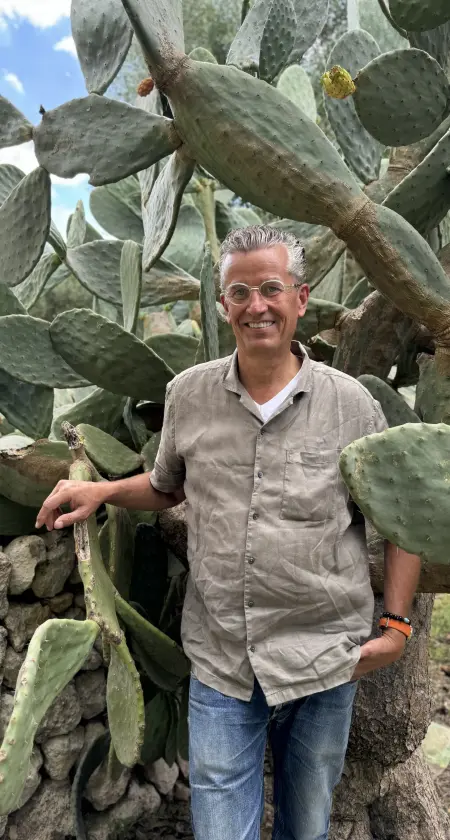
On Mallorca, I recently transplanted a striking specimen of Opuntia ficus-indica. At least 150 years old, it’s gnarled, almost tree-like in form, with a tough, woody trunk and bright yellow-orange fruits – the so-called prickly pears. A plant that blends effortlessly into the landscape of olive trees and dry stone walls.
The prickly pear cactus needs nothing. No water, no fertilizer, no care. It thrives in stony soils and handles heat and drought with ease. Its paddle-shaped segments – sometimes called “beaver tails” – are not leaves but water-storing shoots. The true leaves have been reduced to tiny glochids: fine, barbed spines, almost invisible to the eye but unmistakable to the skin.
And the fruit – the prickly pear, or tuna – is particularly sneaky: touch it carelessly, and you’ll have those tiny spines in your fingers for days. An itchy affair.
Opuntia ficus-indica blooms in yellow, orange, or red. Not only are the resulting fruits edible, but so are the young shoots – the “beaver tails”. In the plant’s native home, they’re a staple of traditional cuisine.
Opuntia ficus-indica originates from Mexico, where it’s called nopal. The young shoots are grilled or boiled and eaten as a vegetable. The sweet, vitamin-rich fruits are a delicacy, somewhat like fruit in character. Nopal is considered anti-inflammatory, nutrient-dense, and incredibly versatile.
By the way: all cacti come from the New World – the American continent – and only arrived in Europe after colonization. Today, Opuntia ficus-indica is widespread across the Mediterranean, especially on islands like Mallorca. It has survived droughts that even the grass couldn’t withstand.
We like to use Opuntia ficus-indica in modern Mediterranean gardens – as a sculptural element with architectural presence. And because it suits the site: dry, nutrient-poor, sunny – that’s how it likes it. In return, it rewards us with bold forms, tough resilience, and edible shoots and fruits that, in times of need, could even save lives.
On Mallorca, the “beaver tails” were once used to fatten pigs. And it’s said that cows survived dry summers by feeding on the cactus’ water-rich pads when there was nothing else to graze.
In Mexico, Opuntia ficus-indica holds great symbolic value. So deeply rooted is it in daily life and culture that it appears on the national flag: an eagle perched on a nopal, a snake in its beak. The image stems from an Aztec founding legend – and to this day, it stands for origin, resilience, and adaptation.